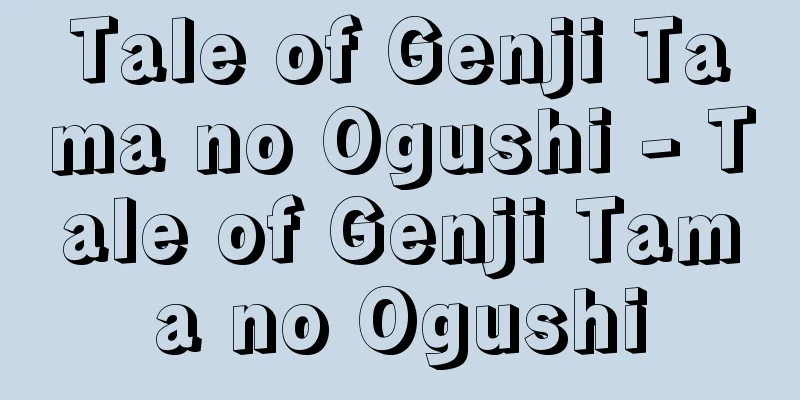Tale of Genji Tama no Ogushi - Tale of Genji Tama no Ogushi

|
This is a commentary on The Tale of Genji written by Motoori Norinaga. He started writing in 1793 (Kansei 5) when he was around 64 years old, finished in 1796, and published in 1799. It is an expanded and revised version of Shibun Yoryo, written 30 years earlier in 1763 (Horeki 13), and it is believed that the author's argument was already formed in his early 30s. Of the nine volumes in total, volumes 1 and 2 are general discussions, volume 3 is a dating, volume 4 is revisionary revisions, and volumes 5 and onwards are commentaries. The main point of this book is that it argues that the essence of The Tale of Genji is "mono no aware," which means a fundamental emotion of the soul that cannot be fully governed by the principles of Confucianism or Buddhism. In this book, for example, he attempts to distinguish between "heart" and "feelings," arguing that the origin of humanity lies in the latter, the emotional. In this way, he attempts to determine the true nature of human beings by freeing stories from the principles of Confucianism and Buddhism. This book is noted as being almost the first literary theory that attempted to grasp the inherent meaning of stories. It has had a considerable influence on later generations. [Hideo Suzuki] "The Complete Works of Norinaga Motoori 4" (1969, Chikuma Shobo) "The Collection of Japanese Classical Literature 94: Collection of Essays on Early Modern Literature" (1966, Iwanami Shoten) edited by Nakamura Yukihiko Source: Shogakukan Encyclopedia Nipponica About Encyclopedia Nipponica Information | Legend |
|
本居宣長(もとおりのりなが)の著した『源氏物語』の注釈書。1793年(寛政5)の64歳ごろ起筆し、96年に完成、99年刊行。これは、それより30年ほど前の1763年(宝暦13)に著した『紫文要領(しぶんようりょう)』を増補改訂したものであり、著者の論旨はすでに30歳代前半において形成されていたとみられる。全9巻のうち、巻1、巻2が総論、巻3が年立(としだて)、巻4が校異、巻5以下が注釈となっている。この書の眼目は、なによりも、『源氏物語』の本質が「もののあはれ」にあるとする点にある。それは、儒教や仏教などの道理では律しきることのできない、魂の根源的な感動を意味する。本書では、たとえば「心(こころ)」と「情(こころ)」を区別する分析を試みるなど、後者の感性的なものにこそ人間の根源があると主張している。こうして、物語を儒仏の道理から解き放つところから、人間の本然的な形姿を見定めようとした。本書は、物語固有の意義をとらえようとした、ほとんど最初の文学論として注目される。後世に与えた影響も少なくない。 [鈴木日出男] 『『本居宣長全集4』(1969・筑摩書房)』▽『中村幸彦校注『日本古典文学大系94 近世文学論集』(1966・岩波書店)』 出典 小学館 日本大百科全書(ニッポニカ)日本大百科全書(ニッポニカ)について 情報 | 凡例 |
>>: The Tale of Genji: Kogetsu-sho
Recommend
Devaram (English spelling)
…Together with Uppal and Sambandar, he laid the f...
Neptune (mythology) (English spelling) Neptune
…He was also the god of earthquakes and horses. H...
Communal land ownership
…Land ownership is one way in which humans are co...
Ordo (monastic order) - Ordo
… Many monasteries established veneration of reli...
caraco
…The lace decoration was concentrated on the larg...
Munkácsy, Michael von Lieb
Born: February 8, 1844. Munkacz [Died] April 30, 1...
visual display terminal
...In advanced equipment, conventions for composi...
Kyoritsu Women's Vocational School
…It was approved as a school corporation in 1951....
Arab national movement
During World War II, plans for national unificati...
Vine Pot - Kazura Tsubo
… In some regions, certain plants, such as Teikak...
The sad story of a factory girl
This is a record of the realities of female facto...
Sanguisorba tenuifolia (English spelling) Sanguisorba tenuifolia
…[Yamanaka Futoshi]. … *Some of the terminology t...
豨薟 - Menamomi
〘Noun〙 An annual plant of the Asteraceae family. I...
Arson - Houka
〘 noun 〙 To light a fire in order to start a fire....
Caramel - Karameru (English spelling) caramel
This refers to sugar that has been boiled down to...



![Toshima [village] - Toshima](/upload/images/67cc57726b0dd.webp)





